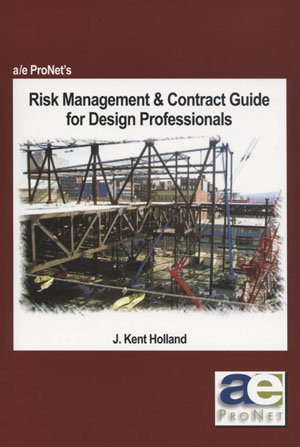Looking for a convenient way to fulfilll your AIA Continuing Education credit requirements? a/e ProNet can help.
In the past few years, a/e ProNet has published two risk management guides for the design industry: Risk Management & Contract Guide for Design Professionals and Risk Management for Design Professionals in a World of Change. Both include courses at the back of the book, which have just been renewed with the AIA for credit for an additional 3 years.
Our books and access to the courses are available for purchase on our website, but you can receive a discount for both by requesting copies from your a/e ProNet broker. (And if your broker isn’t an a/e ProNet member, call your local a/e ProNet broker today!)
Read on for details about both contract review guides…
Risk Management & Contract Guide for Design Professionals
 Over 300 pages of commentary on risk management and contracts. Written by attorney, J. Kent Holland, based upon his knowledge and experience from over 20 years working with design professional contracts, risk management and insurance. This is a practical guide to help design professionals and those who work with design professionals to better understand and manage risks and liabilities potentially arising out of contracts, communication, and documentation. Much attention is given to explaining how contract language may affect the availability of insurance coverage for claims against design professionals. Several chapters address managing communication and documentation, with particular emphasis on e-mail, and records maintenance, retention, and destruction. Over 30 clauses that may be of particular concern for risk management and insurability of risks are discussed. For each of these clauses, one or more key issues is considered. Extensive examples and commentary are offered on various provisions of the AIA and EJCDC forms. In addition to discussing example contract clauses, we have included a discussion of risk management of communication and documentation. As you will see from the litigation examples referenced, many claims against design professionals could be avoided or mitigated through better communication and documentation. This is such an important issue that entire seminars are devoted to it. WHO SHOULD GET IT? (1) Attorneys and insurance brokers that advise design professionals on their contracts and the insurability of contract language; (2) design professionals who desire to have more information and reasoning to use during their contract negotiations with project owners; (3) project owners who desire to understand what and why design professionals are seeking certain language in their contracts and rejecting language proposed by owners. They will also benefit from learning what professional liability insurance can and cannot cover in the way of claims against design professionals. (4) Educators will find this book a useful tool to teaching practical application of the concepts of risk management. The book can easily be used as course book and even provides continuing education quizzes for three distinct continuing education courses based upon reading various chapters of the book.
Over 300 pages of commentary on risk management and contracts. Written by attorney, J. Kent Holland, based upon his knowledge and experience from over 20 years working with design professional contracts, risk management and insurance. This is a practical guide to help design professionals and those who work with design professionals to better understand and manage risks and liabilities potentially arising out of contracts, communication, and documentation. Much attention is given to explaining how contract language may affect the availability of insurance coverage for claims against design professionals. Several chapters address managing communication and documentation, with particular emphasis on e-mail, and records maintenance, retention, and destruction. Over 30 clauses that may be of particular concern for risk management and insurability of risks are discussed. For each of these clauses, one or more key issues is considered. Extensive examples and commentary are offered on various provisions of the AIA and EJCDC forms. In addition to discussing example contract clauses, we have included a discussion of risk management of communication and documentation. As you will see from the litigation examples referenced, many claims against design professionals could be avoided or mitigated through better communication and documentation. This is such an important issue that entire seminars are devoted to it. WHO SHOULD GET IT? (1) Attorneys and insurance brokers that advise design professionals on their contracts and the insurability of contract language; (2) design professionals who desire to have more information and reasoning to use during their contract negotiations with project owners; (3) project owners who desire to understand what and why design professionals are seeking certain language in their contracts and rejecting language proposed by owners. They will also benefit from learning what professional liability insurance can and cannot cover in the way of claims against design professionals. (4) Educators will find this book a useful tool to teaching practical application of the concepts of risk management. The book can easily be used as course book and even provides continuing education quizzes for three distinct continuing education courses based upon reading various chapters of the book.
–> Risk Management & Contract Guide for Design Professionals is out of print, but IS available in electronic format. You can preview the inside of the book at Amazon.com. It is possible to purchase the guide (and access to the AIA-approved CE courses) via the a/e ProNet Store, but you may also contact your local a/e ProNet broker and request a discounted copy.
Risk Management for Design Professionals in a World of Change
 Risk management for design professionals truly is in a world of change. Changes taking place across the globe are creating a vastly different professional environment for architects and engineers as we move further into the 21st century. Of the new risks confronting design professionals, those of going green and meeting the sustainability requirements of contracts and new laws may prove to be among the most significant. Through the insights and experiences of some of the industry’s most experienced practitioners, this book offers the reader a practical perspective on how to understand and successfully address these risks. Chapter 1 describes positive experiences of architects in designing with the goal of producing environmentally responsible projects. While there is much to commend green design, however, it produces risks that may impact legal liability and insurance, risks that are perhaps not well enough understood and appreciated. Several additional chapters explain how to recognize these risks and include thought-provoking claim scenarios that should be considered with regard to making the risk insurable. Significant new standard form contract documents have been published in the last couple years. There are chapters addressing the new American Institute of Architects, AIA B101-2007 documents as well as the new ConsensusDOCS and Engineering Joint Contract Documents Committee (EJCDC) contract documents. The chapters on the contract documents emphasize changes from the previous generation of documents and in particular how these changes may impact the risks borne by design professionals. The book then moves on to the risks arising out of Integrated Project Delivery (IPD) and Building Information Modeling (BIM). One chapter presents a comprehensive discussion dealing with the legal aspects of designing with BIM, and the risks arising out of BIM. This provides concerns that project owners, designers, and contractors should consider when using BIM and it offers practical guidance for addressing some of the key risks that will result from BIM. Another chapter addresses the opportunities and risks arising out of public private partnership (P3) construction projects. The authors of the chapter write from the perspective of having negotiated contracts and assisted on legal and risk management issues on numerous major P3 projects. The final chapters address the risks that are unique to international projects and in particular how to insure those risks.
Risk management for design professionals truly is in a world of change. Changes taking place across the globe are creating a vastly different professional environment for architects and engineers as we move further into the 21st century. Of the new risks confronting design professionals, those of going green and meeting the sustainability requirements of contracts and new laws may prove to be among the most significant. Through the insights and experiences of some of the industry’s most experienced practitioners, this book offers the reader a practical perspective on how to understand and successfully address these risks. Chapter 1 describes positive experiences of architects in designing with the goal of producing environmentally responsible projects. While there is much to commend green design, however, it produces risks that may impact legal liability and insurance, risks that are perhaps not well enough understood and appreciated. Several additional chapters explain how to recognize these risks and include thought-provoking claim scenarios that should be considered with regard to making the risk insurable. Significant new standard form contract documents have been published in the last couple years. There are chapters addressing the new American Institute of Architects, AIA B101-2007 documents as well as the new ConsensusDOCS and Engineering Joint Contract Documents Committee (EJCDC) contract documents. The chapters on the contract documents emphasize changes from the previous generation of documents and in particular how these changes may impact the risks borne by design professionals. The book then moves on to the risks arising out of Integrated Project Delivery (IPD) and Building Information Modeling (BIM). One chapter presents a comprehensive discussion dealing with the legal aspects of designing with BIM, and the risks arising out of BIM. This provides concerns that project owners, designers, and contractors should consider when using BIM and it offers practical guidance for addressing some of the key risks that will result from BIM. Another chapter addresses the opportunities and risks arising out of public private partnership (P3) construction projects. The authors of the chapter write from the perspective of having negotiated contracts and assisted on legal and risk management issues on numerous major P3 projects. The final chapters address the risks that are unique to international projects and in particular how to insure those risks.
Visit the a/e ProNet store for more risk management materials like these!
Please Note: The courses in both books have just been renewed with the AIA for credit for an additional 3 years. Please disregard the course expiration date indicated in the books.



